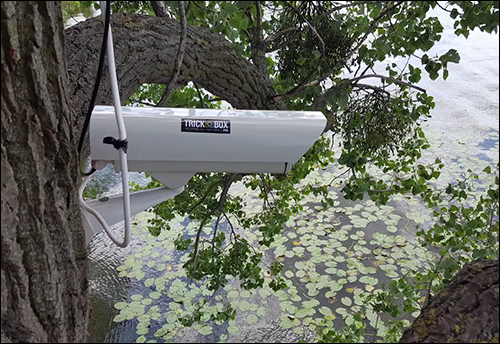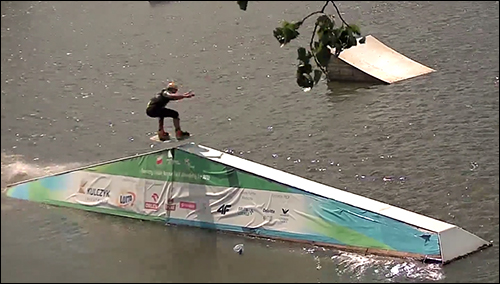Nov 29, 2016Polish sports technology company Trickbox has deployed a Near Field Communication (NFC) RFID-based system provided by HADATAP at a Polish Wakeboard water park known as Wawawake to monitor the amount of time each participant spends riding at the park, as well as to match that customer to videos taken of him or her. HADATAP is using SkyeTek SkyeModule NFC readers, as well as its own cloud-based software that links the read data with both ticketing and video footage.
Wakeboarding, a combination of water skiing, snowboarding and surfing, is an extreme water sport in which athletes use a board to surf the waves while being towed by a line connected to a motorboat or closed-course cable system. Wawawake is situated on a lake near Warsaw, Poland. During warmer months—typically from May through September—the park provides a place for wakeboarders to practice their skills on jumping ramps and obstacles. Because it involves many jumps and tricks, the sport lends itself well to videos that can catch the drama frame by frame.
Wakeboard riders like to view their own performance on these jumps, not only for fun but also to evaluate their own technique for training purposes. Therefore, the park wanted to offer them a way to view such video footage during their visit. "Riders like to jump from the obstacles on water doing different tricks, sometimes very fancy," says entrepreneur Kamil Luberecki, Trickbox's founder.
Trickbox makes integrated technology solutions for sports parks like Wawawake. It began developing the water park's system this year, and enlisted HADATAP to provide RFID readers and wristbands to identify visitors. HADATAP supplied wristbands with integrated Smartrac NFC RFID tags and installed SkyeModule RFID readers at the entrance to the bridge where participants await their turn in the water, and at a kiosk. HADATAP's cloud-based software interprets the collected read data, links it to billing and videos, and forwards that information to Trickbox's server. The system was taken live in August of this year.
"RFID is used to link the user with archived video," says Daniel Kamiński, the president of HADATAP's board.
Before visiting Wawawake, users make a reservation online and pay for a specific time on the water ride (known as a loop). They may, for instance, pay for 60 minutes, which could equate to a specific number of loops. Upon arriving at Wawawake this past summer, each visitor provided his or her identification and received an RFID-enabled wristband linked to the reservation. When the guest went to a bridge that accessed the lake, he or she tapped the bracelet against the entrance gate's NFC reader, after which the software began tracking how long the individual was on the water, so that usage could then be billed accordingly.
They then queued up on the bridge to use a wakeboarding loop, where a high-speed cable would pull them along the water's surface. The ID number encoded to the wristband's tag was stored in the Trickbox software, along with the participant's information. As each visitor moved through the loop, multiple Samsung IP cameras automatically recorded his or her performance.
When a visitor completed the loop, he or she tapped another reader. The system then identified how long the individual had remained on the water, and deducted that time from the amount purchased.
The main challenge involved integration between the RFID system and the IP cameras, Kamiński says. "We initiated close cooperation with the producer," he explains, "and adopted cameras' API [application programming interface] to our system." The API enabled the tag ID of a participant's wristband to be linked with the video footage captured of that individual. That data was managed on HADATAP's cloud-based server.
The user could later access those videos by tapping the wristband against the reader installed in the kiosk at the rest area. Upon leaving the park, the customer again tapped the bracelet against a reader installed at the exit, enabling the software to calculate the fee to charge that guest, based on the amount of billable time.
Visitors could also log in at the Trickbox website for seven days after leaving the park, and then use the wristband's ID number to download, edit and share their videos via social media.
There are some unique challenges to deploying RFID in a water-sport environment, Luberecki notes. "This is a very new field of application for RFID readers and wristband tags," he states—for one thing, the wet environment posed challenges for the hardware. According to Luberecki, the wristbands had to sustain not only water but high-speed—sometimes violent—forces during falls.
The Trickbox technology has been well received by the park's visitors, Luberecki reports. "They were thrilled since the very first day when they saw the power of the recording automation, super-high-quality of the movies and ability to watch them both on the spot and at home."
For future installations, HADATAP intends to use ultrahigh-frequency (UHF) RFID technology rather than NFC to expedite the capture of wristband data, due to the long read range of UHF technology. Luberecki predicts that this use of NFC technology, paired with video cameras—which allows individuals to capture footage of their sports performance—is "the beginning of a new technology trend: recording as a service."



